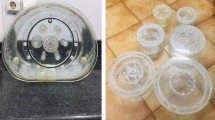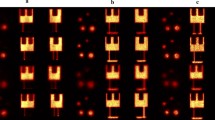Abstract
The purpose of this work was to improve of the spatial resolution of a whole-body positron emission tomography (PET) system for experimental studies of small animals by incorporation of scanner characteristics into the process of iterative image reconstruction. The image-forming characteristics of the PET camera were characterized by a spatially variant line-spread function (LSF), which was determined from 49 activated copper-64 line sources positioned over a field of view (FOV) of 21.0 cm. This information was used to model the image degradation process. During the course of iterative image reconstruction, the forward projection of the estimated image was blurred with the LSF at each iteration step before the estimated projections were compared with the measured projections. The imaging characteristics of the high-resolution algorithm were investigated in phantom experiments. Moreover, imaging studies of a rat and two nude mice were performed to evaluate the imaging properties of our approach in vivo. The spatial resolution of the scanner perpendicular to the direction of projection could be approximated by a one-dimensional Gaussian-shaped LSF with a full-width at half-maximum increasing from 6.5 mm at the centre to 6.7 mm at a radial distance of 10.5 cm. The incorporation of this blurring kernel into the iteration formula resulted in a significantly improved spatial resolution of about 3.9 mm over the examined FOV As demonstrated by the phantom and the animal experiments, the high-resolution algorithm not only led to a better contrast resolution in the reconstructed emission scans but also improved the accuracy for quantitating activity concentrations in small tissue structures without leading to an amplification of image noise or image mottle. The presented data-handling strategy incorporates the image restoration step directly into the process of algebraic image reconstruction and obviates the need for ill-conditioned ”deconvolution“ procedures to be performed on the projections or on the reconstructed image. In our experience, the proposed algorithm is of special interest in experimental studies of small animals.
Similar content being viewed by others
References
Hoffman EJ, Huang SC, Phelps ME. Quantitation in positron emission computed tomography. I. Effect of object size.J Comput Assist Tomogr 1979; 3: 299–308.
Brix G, Zaers J, Adam LE, et al. Performance evaluation of a whole-body PET scanner using the NEMA protocol.J Nucl Med 1997; in press.
Derenzo SE, Huesman RH, Cahoon JL, et al. A positron tomograph with 600 BGO crystals and 2.6 mm resolution.IEEE Trans Nucl Sci 1988; 35: 659–664.
Spinks TJ, Jones T, Bailey DL, et al. Physical performance of a positron tomograph for brain imaging with retractable septa.Phys Med Biol 1992; 37: 1637–1655.
Freifelder R, Karp JS, Geagan M, Muehllehner G. Design and performance of the HEAD PENN-PET scanner.IEEE Trans Nucl Sci 1994; 41:1436–1440.
Tavernier S, Bruyndonckx P, Shuping Z. A fully 3D small PET scanner.Phys Med Biol 1992; 37: 635–643.
Cutler PD, Cherry SR, Hoffman EJ, Digby WM, Phelps ME. Design features and performance of a PET system for animal research.J Nucl Med 1992; 33: 595–604.
Marriott CJ, Cadorette JE, Lecomte R, Scasnar V, Rousseau J, van Lier JE. High-resolution PET imaging and quantitation of pharmaceutical biodistribution in a small animal using avalanche photodiode detectors.J Nucl Med 1994; 35: 1390–1397.
Magata Y, Saji H, Choi SR, et al. Noninvasive measurement of cerebral blood flow and glucose metabolic rate in the rat with high-resolution animal positron emission tomography (PET): a novel in vivo approach for assessing drug action in the brain of small animals.Biol Pharm Bull 1995; 18: 753–756.
Bloomfield PM, Rajeswaran S, Spinks TJ, et al. The design and physical characteristics of a small animal positron emission tomograph.Phys Med Biol 1995; 40: 1105–1126.
Andrews HC, Hunt BR. Digital image restoration. Englewood Cliffs, New Jersey: Prentice-Hall, 1977.
Webb S. The mathematics of image formation and image processing. In: Webb S, ed.The physics of medical imaging. Bristol and Philadelphia: Institute of Physics Publishing; 1988:534–566.
Pratt WK. Digital image processing, 2nd edn. New York: Wiley; 1991: 323–419.
Webb S, Long AP, Ott RJ, Leach MO, Flower MA. Constrained deconvolution of SPELT liver tomograms by direct digital image restoration.Med Phys 1985; 12: 53–58.
Webb S. Comparison of data-processing techniques for the improvement of contrast in SPET liver tomograms.Phys Med Biol 1985; 30: 1077–1086.
Derenzo SE. Mathematical removal of positron range blurring in high resolution tomography.IEEE Trans Nucl Sci 1986; 33: 565–569.
Huesman RH, Salmeron EM, Baker JR. Compensation for crystal penetration in high resolution positron tomography.IEEE Trans Nucl Sci 1989; 36: 1084–1089.
Liang Z. Detector response restoration in image reconstruction of high resolution positron emission tomography.IEEE Trans Med Imaging 1994; 13: 314–321.
Luig H, Eschner W, Bähre M, Voth E, Nolte G. Eine iterative Strategie zur Bestimmung der Quellverteilung bei der Einzelphotonen-Tomographie mit einer rotierenden Gammakamera (SPELT).Nuklearmedizin 1988; 27: 140–146.
Shepp LA, Vardi Y. Maximum likelihood reconstruction for emission tomography.IEEE Trans Med Imaging 1982; 1: 113–122.
Vardi Y, Shepp LA, Kaufman L. A statistical model for positron emission tomography.J Am Stat Assoc 1985; 80: 8–20.
Lewitt RM, Muehllehner G. Accelerated iterative reconstruction for positron emission tomography based on the EM algorithm for maximum likelihood estimation.IEEE Trans Med Imaging 1986, 5: 16–22.
Zeng GL, Gullberg GT. Valid backprojection matrices which are not the transpose of the projection matrix [abstract].J Nucl Med 1996; 37: 206P.
Kamphuis C, Beekman FJ, Viergever MA, van Rijk PP. Accelerated fully 3D SPELT reconstruction using dual matrix ordered subsets [abstract].J Nucl Med 1996; 37: 62P.
Ostertag H, Kübler WK, Doll J, Lorenz WJ. Measured attenuation correction methods.Eur J Nucl Med 1989; 15: 722–726.
Bergström M, Eriksson L, Bohm C, Blomqvist G, Litton J. Correction for scattered radiation in a ring detector positron camera by integral transformation of the projections.J Comput Assist Tomogr 1983; 7: 42–50.
Hoverath H, Kübler WK, Ostertag HJ, et al. Scatter correction in the transaxial slices of a whole-body positron emission tomograph.Phys Med Biol 1993; 38: 717–728.
Schuhmacher J, Klivényi G, Matys R, et al. Multistep tumor targeting in nude mice using bispecific antibodies and a gallium chelate suitable for immunoscintigraphy with positron emission tomography.Cancer Res 1995; 55: 115–123.
Watson CC, Newport D, Casey ME. A single scatter simulation technique for scatter correction in 3D PET. In: Grangeat P, Amans JL, eds. Three-dimensional image reconstruction in radiology and nuclear medicine. Dordrecht: Kluwer; 1996: 255–268.
Derenzo SE. Initial characterization of a BGO-silicon photodiode detector for high resolution positron emission tomography.IEEE Trans Nucl Sci 1984; 31: 620–626.
Karp JS, Daube-Witherspoon ME. Determination of depth-ofinteraction in scintillation crystals using a temperature gradient.Nucl Instrum Meth 1987; A260: 509–517.
Derenzo SE, Moses WW, Jackson HG, et al. Initial characterization of a position-sensitive photodiode/BGO detector for PET.IEEE Trans Nucl Sci 1989; 36: 1084–1089.
Yamashita T, Watanabe M, Shimizu K, Uchida H. High resolution block detectors for PET.IEEE Trans Nucl Sci 1990; 37: 589–593.
Bartzakos P, Thompson CJ. A PET detector with depth-of-interaction determination.Phys Med Biol 1991; 36: 735–748.
Rogers JG. A method for correcting the depth-of-interaction blurring in PET cameras.IEEE Trans Med Imaging 1995; 14: 146–150.
Brix G, Bellemann ME, Haberkorn U, Gerlach L, Lorenz WJ. Assessment of the biodistribution and metabolism of 5-fluorouracil as monitored by18F- PET and19F MRI: a comparative animal study.Nucl Med Biol 1996; 23: 897–906.
Author information
Authors and Affiliations
Additional information
This paper is dedicated to Professor Dr. Walter J. Lorenz, on the occasion of his 65th birthday
Rights and permissions
About this article
Cite this article
Brix, G., Doll, J., Bellemann, M.E. et al. Use of scanner characteristics in iterative image reconstruction for high-resolution positron emission tomography studies of small animals. Eur J Nucl Med 24, 779–786 (1997). https://doi.org/10.1007/BF00879667
Received:
Revised:
Issue Date:
DOI: https://doi.org/10.1007/BF00879667




